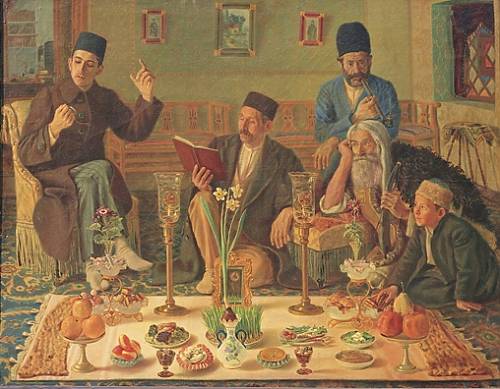Nowruz is the beginning of the new Iranian year and one of the most important ancient Iranian land, and also the most important of them. The history of this celebration dates back to thousands of years before Islam.
In this issue we are not seeking historical review of Nowruz Celebration, But briefly to the customs of the people in Iran, especially the people of Khomein city.
Before Islam, the Iranian people based on their beliefs were special celebrations and ceremonies and with Top of Form
Advent of Islam and spread of Islam among the Iranian people, some of these beliefs and the ceremony were completely abrogated. Top of Form
But some of them did not conflict with the spirit of the Islamic teachings were accepted and little by little the Islamic teachings influenced on them But still remained as a celebration of the Iranian people.
Nowruz is a symbol of peace, affection, love of nature and sign of a look to the future and Iranians’ perfectionism. Choose the time to liven up the nature and growth of Sprouts as the beginning of the New Year is a sign of Iranian intelligence.
The Iranian people, regardless of their ethnicity and religion, cherish Nowruz as the national ceremony. The customs of the Nowruz celebration will be held in all cities and villages of Iran. Most of these customs are the same but some of these customs has changed in accordance with each region and has become more important.
The first day of Farvardin (March 20) and beginning day of Nowruz Celebrations and also, the beginning of the new Iranian or solar year. In ancient Iran, these festivities have continued for two weeks and on the fourteenth day of April have been terminated.
The 13th day of Farvardin, which is known as the “sizdah be-dar” has a lot of importance. Iranian families spend this day in the nature.
The customs of Khomein people on Nowruz
In the Mood of Esfand
In the last month of the solar year, which is called Esfand there is a special stir among the people, Housewives, with the help of other members of the family, dusting and washing all the home furnishings and so-called “khaneh-tekani” Walls and windows become clean. Wonderful Iranian rugs and carpets washed in rivers or local aqueducts and hung on the roofs to dry.
The sense of being new and clean becoming widespread, change could be found everywhere. People prepare themselves for New Year’s Eve. Markets are very busy especially sales market, nuts and red fish and colorful flowers such as violets and hyacinth. Everyone with a particular passion waiting for the moment of the beginning of New Year.
Chaharshanbe suri or fire festival
Another one of the ancient Iranian ceremonies is Chaharshanbe soori. The eve of the last Wednesday or evening of the Tuesday (marks the arrival spring). People make fire with firewood in the yard or the roofs of houses. All family members with joy Jumping over the fire and singing ”zardi man as to –sorkhi to az man”. Meaning “give me your red color and take back my sickly pallor.” This tune is sung to dispose of sickness and difficulties, and to replace that with health, wealth, and happiness for the better future.
Chaharshanbe suri or fire festival
Chaharshanbe suri
New Year transition moment (from one year to the next)
The moment of transition is based on accurate calculations, the ground after about 365 Days once again rotated around the sun. People try to be with their families in this hour.
In the all houses people spread haft sin and all the family members are sitting around it and waiting for the moment of transition of New Year. At the moment of transition of New Year family members kissing each other and have the best wishes for each other.

Haft sin tablecloth
Haft sin is the tablecloth that Iranian decorate at the moment of Nowruz. This tablecloth can be laid out on the floor or on the table. Family members usually spend the moment of transition of New Year at the next to the Haft sin table. Some people also hold the table for about thirteen days after Nowruz, and at the end of the course, on the thirteenth day of Nowruz, they will throw the Sabzeh in the water.
In the Haft sin table usually begins with words that are more than seven or sin
۱) Sabzeh (sprouts)
Perhaps the most beautiful feature of the Haftin’s table can be said to be its Sabzeh. Because sabzeh makes their hearts happy with his own color and refreshing and by looking at it, makes the New Year more beautiful. Top of Form
It was the custom in ancient Iran which is 25 days before Nowruz in the Palace of the Kings, were set up 12 columns of crude adobe. And to seeds grain each top of them and believe that if sabzeh grow up well, has the luxuriance year. The grain that to seeds today most of them are wheat and lentil.
۲) Sib (apple)
Sib symbol of health and beauty. Mother or grandmother put the Sib on the tablecloth Perhaps because we have all been seeing the mother’s anxiety and concern for the health of the members of the house.
۳) Samanoo (sweet pudding)
Samanoo is made from newly emerging wheat germs, a symbol of the food abundance and good food and high-quality foods and it is also a symbol for plant breeding and fertilizing plants.
۴) Senjed (dried fruit from lotus tree)
The aroma of senjed leaves and blossoms of it stimulant love and affection and It is a prerequisite for generic fertility, Should be on the Haft sin table. The presence of Senjed in the Nowruz tablecloth is motive for cosmic birth.
۵) Sir (garlic)
Garlic symbolizes the germs detoxification and environmental cleanliness and body health it will keep you from the evil eye. Should be placed on the table. Zoroastrians believe that the smell of garlic escapes the demons. Zoroastrians put garlic with pieces of bread over the table. They never throw out garlic peel because they believe that worse than magic. For this reason, to peel it, first, put the garlic in water, And then they peel off the garlic, They also believe that if the garlic peel with onions, rampion and incense are burned in the house, Especially on the morning of Thursday, the smell of it, cleans the air in the house.
۶) Serkeh (vinegar):
Like garlic represents the purity of the environment, eliminate pollution and dispel magic.
۷) Somagh (sumac)
Somagh is the symbol of love, which is placed on the Haft-sin table cloth.
But according to the influence of people’s beliefs on ancient religions over time, other components such as the Quran, Hafez and Sa’di poetry books, water, red fish, bread, coin, mirror and … have been added to the Haft- Sin table.
First day of Nowruz
On this day, the first day of the first four-days of official holiday in Iran. People wearing new clothes and visit their friends and relatives. The elders of the family, especially grandfathers and grandmothers are in the top priority. They are also giving a gift, which is usually a common Iranian currency and guests will be welcomed with other gifts. Eidy (gift or money) payments are especially prevalent for children and make them happy. Boiled eggs painted in various designs, including other grandmother’s gifts to their grandchildren.
Reception of guests with nuts, which usually includes pumpkin seeds, watermelon and sunflower seeds, almonds, walnuts, pistachios, hazelnuts, roasted chickpea known as (Nokhodchi), raisins and another dried fruits such as fig and apricot. This reception isn’t custom another days of the year. In Khomein, and especially in the surrounding villages, in addition to nuts, it is served for Nowruz’s guests with a cookie called ‘Sugar cookies ‘ made from wheat flour, milk, sugar and animal oil.
A very good tradition during the days of Nowruz, people settle the disagreement, and also forgive each other from each other’s mistakes and friendship between those who may have problems over the course of the year.
Mood of Nowruz more or less continuous until thirteen days of Nowruz and will gradually reduce its excitement.
Sizdah Be-dar(Nature’s Day)
On the 13th of Farvardin, the first month of the year, known as Sizdah Be-dar. On this day, which is in fact the last day of the Nowruz celebrations, people spend their day with their families and friends in the nature and enjoy the mood of first spring months of the year, enjoying their colorful blossoms and beautiful sprouts on the branches of the trees and greensward. Sizdah Be-dar has special importance as an Iranian celebration among all Iranian people, and few have the opportunity to spend this glorious day at home. Sizdah Be-dar, the final point is on Nowruz celebrations, and the beginning of a new year, combined with effort and perseverance to make a better future.
In Mishijan village, which is located five kilometers from the Khomein city. In the past, people were allowed to visited Prince Amir Heshmat mansion or Mishijan historical castle on the Sizdah Be-dar day and at the moment of the exit they had received branch of the beautiful and unique flowers of this beautiful garden as the gift. The historical Mishijan castle, which has suffered a lot in the recent years, now is under reconstruction.
The impact of Islam on Nowruz rituals
As noted earlier, after the advent of Islam in Iran, many of the rituals were abolished and many were influenced by Islamic teachings and were accepted.
Nowruz is one of the rituals that has affected the Islamic teachings but still, as an Iranian Celebration between Iranians and the people of some countries that have been considered in the last part of the territory of Iran, like Afghanistan, Tajikistan, Azerbaijan and even part of India.
In general, the impact of Islam on Nowruz has been an expression for the following issues:
The presence of the Muslim people in religious holy places at the moment of New Year
Quran added as the holy book of Muslims to the Haft-sin table
Promoted Quranic Haft-sin including greetings presented in the Quran along with the Iranian Haft-Sin table
Added Islamic prayers and supplications at the moment of Nowruz
Pilgrimage tombs of Dead people on the First Day of Nowruz
Eliminated celebrating among some of the Iranian tribes has been common in Nowruz
Giving priority to religious festivals and rituals, due to the rotation of the lunar months, which is the basis of Islamic occasions, these occasions coincide with the day of Nowruz.
The Iranian people who accepted Islam with open arms and services is also very important to spread Islam, although in many cases the disfavor, oppression and humiliation of some of the caliph and the name of Islam, but they never did not write this oppression to the principle of Islam and Islamic teachings, And instead of relying on Islamic teachings, a new spirit of their national and artistic combination of beauty created from nationality and religion.
Author: Ali Mohammad Panahi

